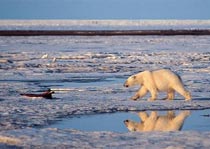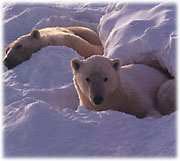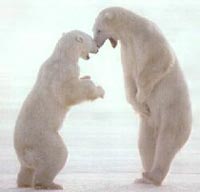| (insert your NIE or newspaper logo here) |
Weekly Online LessonOnline Lesson ArchiveGrade Level: 5-7
|
Life in the Arctic
 A
report released on Monday, November 8, 2004, warns that the world may
lose its roaming, wild polar bears by the year 2100. And the projected
scenarios for other Arctic natives are almost as grim.
A
report released on Monday, November 8, 2004, warns that the world may
lose its roaming, wild polar bears by the year 2100. And the projected
scenarios for other Arctic natives are almost as grim.
More than 250 scientists produced the report, "Impacts of a Warming Arctic," and it was funded by the Arctic Council, which represents eight nations, including the United States. It is the biggest survey of the Arctic climate ever completed.
The scientists conclude that global warming has raised the temperatures of the Arctic twice as fast as the rest of the world over the last few decades. They project that temperatures there will rise 8 to 14 degrees Fahrenheit over the next century, affecting not only polar bears, but other native plants, wildlife and people who live in the region.
Some may think that having shorter, warmer winters with less snow would be a good thing here, but it's not -- not for these natives that have adapted to the Arctic's particular, and relatively predictable, climate over thousands of years.
In this week's lesson, you'll investigate what living in the Arctic is like for people, plants and animals, with a special focus on polar bears.
A Bear's World
 To
get started, let's hook up with one of National Geographic's photographers
and take a look at Bear
Beginnings: New Life on the Ice.
To
get started, let's hook up with one of National Geographic's photographers
and take a look at Bear
Beginnings: New Life on the Ice.
First, get yourself situated by reading the introduction then reviewing a Map of the Arctic shown at the lower left-hand corner of the page.
Then get out in the field through the feature's Sights & Sounds: Multimedia Special. If you already have the Flash Player installed, click I have it then Begin Journey to start rolling the slideshow.
After the slideshow, Zoom In on all of the photos and facts presented in the photo gallery on the left-hand side of the feature page. If you have time, listen to Norbert Rosing describe how he was able to photograph these bears.
Where do the bears find shelter? What are some of the activities the bears participate in during their day? What proportion of the mother bear's milk is fat? About how long do cubs stay with their mom until they head out on their own? What color is a polar bear's hair?
Let's dig a little deeper into the science of polar bears and their Arctic world by visiting the World Wildlife Fund's Polar Bear Tracker.
 Here,
you'll Meet
the bears named Samantha, Viira, and Marianne. Find out
Where they have been, review the Project
Area, and see what scientists have to do to Track
bears.
Here,
you'll Meet
the bears named Samantha, Viira, and Marianne. Find out
Where they have been, review the Project
Area, and see what scientists have to do to Track
bears.
During which month was each bear traveling the most? Why do scientists put radio collars on female bears only?
Next, learn even more About polar bears, by researching their Habitat, Characteristics, Diet, and Family life.
What are the average temperatures when the Arctic is at its warmest and coldest?How are polar bears adapted to the region's climate? What time of year do polar bears eat the most? When do they eat the least? What types of prey do they hunt?
In what ways do polar bears depend on the presence of ice and snow to live? Do bears behave differently when near human settlements?
Now that you know some things about their basic biology, discover what conditions put Polar bears at risk, including Climate change, Toxic pollution, Oil exploration, and Hunting.
In what ways do these conditions make life more dangerous for polar bears? In which areas of the Arctic do these different threats affect them the most and why?
Other Arctic Natives
 Of
course, polar bears aren't the only natives living in The
Arctic. And, as you'll soon discover, many other animals,
as well as plants and people, are or will be facing the consequences
of rapid climate change.
Of
course, polar bears aren't the only natives living in The
Arctic. And, as you'll soon discover, many other animals,
as well as plants and people, are or will be facing the consequences
of rapid climate change.
At this website created by a school group in Saskatchewan, read the Introduction, then explore how native People live here.
In what ways do Arctic residents depend on the ice and snow? What kinds of clothes, homes, and transportation are available? What do the people eat? How do you think the warmer temperatures will affect native peoples?
Next, get back out in the field to take a look at the Arctic's native Animals and Plants.
What types of plants grow here and why? What does each kind of animal eat? In what ways has each species adapted for surviving the Arctic's climate and seasonal changes? Do you think each species will be able to survive these rapid climate shifts, and, if so, how exactly?
If you have time for an even deeper exploration of Arctic natives and the challenges of climate change, check out the report, Impacts of a Warming Arctic.
Newspaper Activities
Watch for articles in Targetnewspaper featuring news on how native peoples, plant, or animal species are responding to climate changes. Are any governments or organizations doing anything to help alleviate some of the effects? Can you find any reports about how changes in the Arctic are affecting or may affect other parts of the world? Are their any other significant events happening in the Arctic region? If so, how do they affect native populations?
© Copyright 2004
Learners
Online,
Inc.
